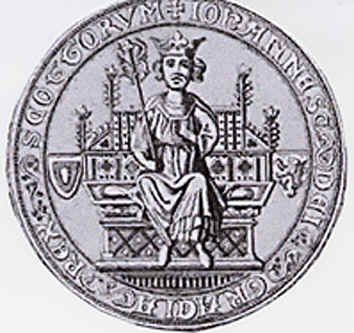 |
King John signing the Magna Carta |
The Magna Carta was signed in June 1215 between the barons of Medieval England and King John. ‘Magna Carta’ is Latin and means “Great Charter”. The Magna Carta was one of the most important documents of Medieval England.
It was signed (by royal seal) between the feudal barons and King John at Runnymede near Windsor Castle. The document was a series of written promises between the king and his subjects that he, the king, would govern England and deal with its people according to the customs of feudal law. Magna Carta was an attempt by the barons to stop a king – in this case John – abusing his power with the people of England suffering.
Why would a king – who was meant to be all powerful in his own country – agree to the demands of the barons who were meant to be below him in authority ?
England had for some years owned land in France. The barons had provided the king with both money and men to defend this territory. Traditionally, the king had always consulted the barons before raising taxes (as they had to collect it) and demanding more men for military service (as they had to provide the men). This was all part of the Feudal System.
So long as English kings were militarily successful abroad, relations with the barons were good. But John was not very successful in his military campaigns abroad. His constant demands for more money and men angered the barons. By 1204, John had lost his land in northern France. In response to this, John introduced high taxes without asking the barons. This was against feudal law and accepted custom.
John made mistakes in other areas as well. He angered the Roman Catholic Church. The pope, vexed by John’s behaviour, banned all church services in England in 1207. Religion, and the fear of Hell, were very important to the people including the barons. The Catholic Church taught the people that they could only gain entrance to Heaven if the Catholic Church believed that they were good enough to get there. How could they show their goodness and love of God if the churches were shut ? Even worse for John was the fact that the pope excommunicated him in 1209. This meant that John could never get to Heaven until the pope withdrew the excommunication. Faced with this, John climbed down and accepted the power of the Catholic Church, giving them many privileges in 1214.
1214 was a disastrous year for John for another reason. Once again, he suffered military defeat in an attempt to get back his territory in northern France. He returned to London demanding more money from taxes. This time the barons were not willing to listen. They rebelled against his power. The barons captured London. However, they did not defeat John entirely and by the Spring of 1215, both sides were willing to discuss matters. The result was the Magna Carta.
 |
What did the Magna Carta bring in?
All 63 clauses of the document can be found here.
The document can be divided into sections :
The first clauses concern the position of the Catholic Church in England.
Those that follow state that John will be less harsh on the barons.
Many of the clauses concern England’s legal system.
Magna Carta promised laws that were good and fair. It states that everyone shall have access to courts and that costs and money should not be an issue if someone wanted to take a problem to the law courts.
It also states that no freeman (i.e. a person who was not a serf) will be imprisoned or punished without first going through the proper legal system. In future years the word “freeman” was replaced by “no one” to include everybody.
The last few sections deal with how the Magna Carta would be enforced in England. Twenty five barons were given the responsibility of making sure the king carried out what was stated in the Magna Carta – the document clearly states that they could use force if they felt it was necessary. To give the Magna Carta an impact, the royal seal of King John was put on it to show people that it had his royal support. This is the largest red seal at the bottom of the Magna Carta above. In detail it looked like this :

King John’s royal seal
![]()